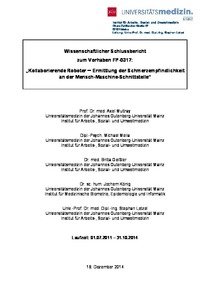Wissenschaftlicher Schlussbericht zum Vorhaben FP-0317: "Kollaborierende Roboter – Ermittlung der Schmerzempfindlichkeit an der Mensch-Maschine-Schnittstelle"
"Collaborative robot systems are increasingly used in industry. Contacts between robots and humans cannot be ruled out with certainty. Thereby clamping events are seen as unwanted events. Future limits for contact forces and pressures will be based, among other things, on pressure pain hreshol...
| Main Authors: | , , , , |
|---|---|
| Institution: | ETUI-European Trade Union Institute |
| Format: | TEXT |
| Language: | German |
| Published: |
Mainz
2014
Institut für Arbeits-, Sozial- und Umweltmedizin |
| Subjects: | |
| Online Access: | https://www.labourline.org/KENTIKA-19396305124911145879-Wissenschaftlicher-Schlussberi.htm |
| Summary: | "Collaborative robot systems are increasingly used in industry. Contacts between robots and humans cannot be ruled out with certainty. Thereby clamping events are seen as unwanted events. Future limits for contact forces and pressures will be based, among other things, on pressure pain hresholds. The goal of the project is to assess pain thresholds at 29 body sites relevant for occupational safety, which will provide the basis of a pain threshold cadaster (force threshold and pressure peaks). The pressure pain threshold (PPT) is defined as the minimum intensity of pressure that is perceived as painful. 100 healthy subjects (40 metal workers, 57 male, range of age 18 – 66 years) were assessed at 29 body sites in three measurement rounds. An automatic algometer with a linear increase in force and a pressure indicating film, which was attached to the probe, were used in the study. Inter-individual variability of PPTs was large (force threshold and pressure peaks). Differences were also observed between different body sites. An example for PPTs of the complete collective at the chewing muscle was 15 (median), 9 and 26 N (10th and 90th percentile), the respective values at the index finger pad of the non-dominant hand were 58, 35 and 102 N. The corresponding pressure peaks were 66, 34 and 182 N/cm² as well as 185, 84 and 341 N/cm². Multivariate analyses revealed that high variability was mostly due to the subjects. Men as well as metal workers had higher pressure pain thresholds, whereas age only played a minor role. Skin irritations or abrasions, respectively, were seldom observed. 10 subjects had minimal hematomas at the pelvis, upper leg and/or calf from the second measurement round on. Overall, 16 hematomas were observed in 12047 measurements. Our data indicate that pressure pain thresholds are a safe limit for clamping and compressive forces at the assessed body sites for healthy persons. Those results cannot readily be transferred to sick people. The determined force thresholds as well as the corresponding pressure peaks are relevant for occupational safety. They will be entered into regulations of the DGUV and passed on to the International Committee for Standardization. It will be for them to decide how these results are going to be accounted for in the Technical Specification 15066 and later in the ISO-Standard 10218. Robotics suppliers and users are therefore given a basis for the safe construction and application of collaborative robots, which will benefit occupational safety." |
|---|---|
| Physical Description: | 88 p. Digital |

